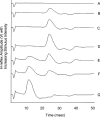Cryotherapy and Transcutaneous Electric Neuromuscular Stimulation Decrease Arthrogenic Muscle Inhibition of the Vastus Medialis After Knee Joint Effusion
- PMID: 12937440
- PMCID: PMC164304
Cryotherapy and Transcutaneous Electric Neuromuscular Stimulation Decrease Arthrogenic Muscle Inhibition of the Vastus Medialis After Knee Joint Effusion
Abstract
OBJECTIVE: Arthrogenic muscle inhibition (AMI) is a presynaptic, ongoing reflex inhibition of joint musculature after distension or damage to the joint. The extent to which therapeutic interventions affect AMI is unknown. The purpose of this study was to verify that the vastus medialis (VM) is inhibited using the knee joint effusion model and to investigate the effects of cryotherapy and transcutaneous electric nerve stimulation (TENS) on AMI using this model. DESIGN AND SETTING: A 3 x 6 analysis of variance was used to compare Hoffmann-reflex data for treatment groups (cryotherapy, TENS, and control) across time (preinjection, postinjection, and 15, 30, 45, and 60 minutes after injection). SUBJECTS: Thirty neurologically sound volunteers (age = 21.8 +/- 2.4 years; height = 175.6 +/- 9.6 cm; mass = 71.5 +/- 13.3 kg) participated in this study. MEASUREMENTS: Hoffmann-reflex measurements were collected using a percutaneous stimulus to the femoral nerve and surface electromyography of the VM. RESULTS: Hoffmann-reflex measurements from the cryotherapy and TENS groups were greater than measurements from the control group at 15 and 30 minutes after injection. Measurements from the cryotherapy group were greater than for the TENS group, and measurements for the TENS group were greater than those for the control group at 45 minutes. At 60 minutes, the cryotherapy group measurements were greater than the TENS and control group measures. Measurements at 15, 30, 45, and 60 minutes after injection were reduced compared with the preinjection and postinjection measurements in the control group. Measurements in the cryotherapy group at 30, 45, and 60 minutes were greater than the preinjection, postinjection, and 15-minute data. No differences between time intervals existed in the TENS group. CONCLUSIONS: Artificial knee joint effusion results in VM inhibition. Cryotherapy and TENS both disinhibit the quadriceps after knee joint effusion, and cryotherapy further facilitates the quadriceps motoneuron pool. Cryotherapy treatment resulted in facilitation of the VM motoneuron pool during the post-treatment phase. The TENS treatment failed to disinhibit the VM motoneuron pool by 30 minutes postinjection.
Figures



Similar articles
-
Knee joint effusion and cryotherapy alter lower chain kinetics and muscle activity.J Athl Train. 2006 Apr-Jun;41(2):177-84. J Athl Train. 2006. PMID: 16791303 Free PMC article.
-
Changes in soleus motoneuron pool excitability after artificial knee joint effusion.Arch Phys Med Rehabil. 2000 Sep;81(9):1199-203. doi: 10.1053/apmr.2000.6298. Arch Phys Med Rehabil. 2000. PMID: 10987162 Clinical Trial.
-
Effect of knee joint effusion on quadriceps and soleus motoneuron pool excitability.Med Sci Sports Exerc. 2001 Jan;33(1):123-6. doi: 10.1097/00005768-200101000-00019. Med Sci Sports Exerc. 2001. PMID: 11194097
-
Comparison of Transcutaneous Electrical Nerve Stimulation and Cryotherapy for Increasing Quadriceps Activation in Patients With Knee Pathologies.J Sport Rehabil. 2016 Aug;25(3):294-300. doi: 10.1123/jsr.2014-0292. Epub 2015 Jan 5. J Sport Rehabil. 2016. PMID: 25559303 Review.
-
The use of focal knee joint cryotherapy to improve functional outcomes after total knee arthroplasty: review article.PM R. 2014 Aug;6(8):729-38. doi: 10.1016/j.pmrj.2014.02.004. Epub 2014 Feb 14. PM R. 2014. PMID: 24534102 Review.
Cited by
-
Chronic ankle instability and corticomotor excitability of the fibularis longus muscle.J Athl Train. 2012 Nov-Dec;47(6):621-6. doi: 10.4085/1062-6050-47.6.11. J Athl Train. 2012. PMID: 23182009 Free PMC article.
-
Bioimpedance spectroscopy for swelling evaluation following total knee arthroplasty: a validation study.BMC Musculoskelet Disord. 2015 Apr 25;16:100. doi: 10.1186/s12891-015-0559-5. BMC Musculoskelet Disord. 2015. PMID: 25907994 Free PMC article.
-
A theoretical framework for understanding neuromuscular response to lower extremity joint injury.Sports Health. 2012 Jan;4(1):31-5. doi: 10.1177/1941738111428251. Sports Health. 2012. PMID: 23016066 Free PMC article.
-
A Better Way to Decrease Knee Swelling in Patients with Knee Osteoarthritis: A Single-Blind Randomised Controlled Trial.Pain Res Manag. 2019 May 2;2019:8514808. doi: 10.1155/2019/8514808. eCollection 2019. Pain Res Manag. 2019. PMID: 31191790 Free PMC article. Clinical Trial.
-
The Ergogenic Effects of Intermittent Palm Cooling on Repeated Baseball Throwing Are Reversed when Cooling-Induced Pain Occurs.J Hum Kinet. 2025 May 29;98:67-77. doi: 10.5114/jhk/194455. eCollection 2025 Jul. J Hum Kinet. 2025. PMID: 40837506 Free PMC article.
References
-
- Hopkins J T, Ingersoll C D. Arthrogenic muscle inhibition: a limiting factor in knee joint rehabilitation. J Sport Rehabil. 2000;9:135–159.
-
- Hopkins J T, Ingersoll C D, Edwards J E, Cordova M L. Changes in soleus motoneuron pool excitability after artificial knee joint effusion. Arch Phys Med Rehabil. 2000;81:1199–1203. - PubMed
-
- Stokes M, Young A. Investigations of quadriceps inhibition: implications for clinical practice. Physiotherapy. 1984;70:425–432.
-
- Nordin M, Frankel V. Basic Biomechanics of the Muskuloskeletal System. 2nd ed Vol. 323. Lea & Febiger; Philadelphia, PA: 1989.
LinkOut - more resources
Full Text Sources
Medical
